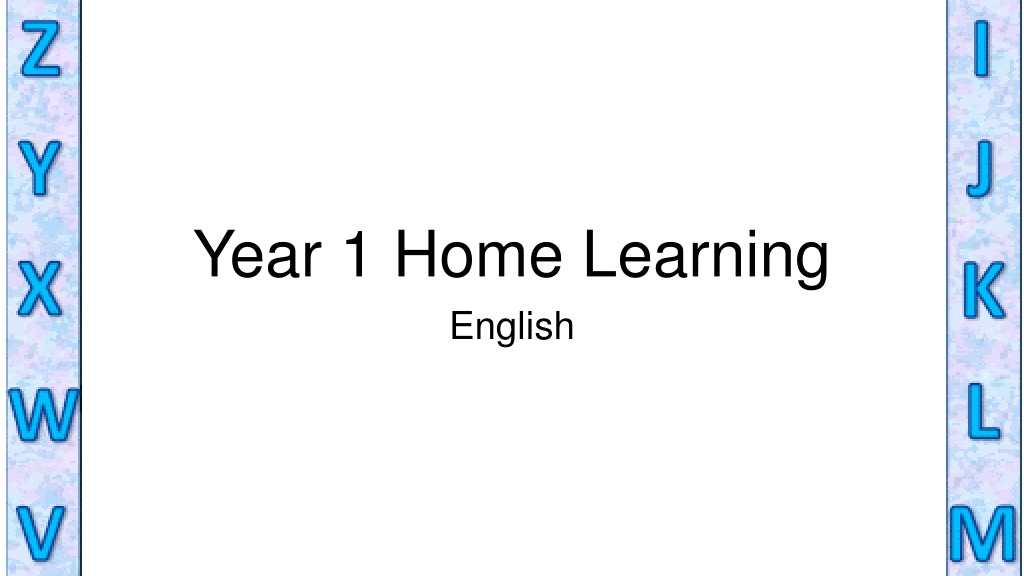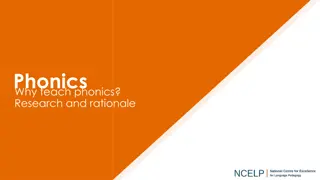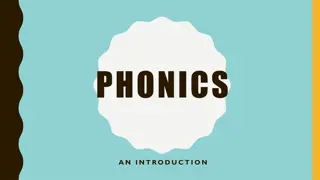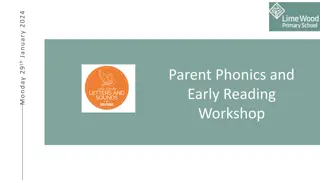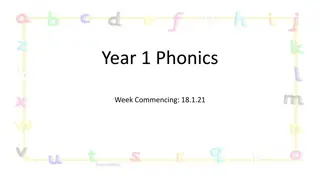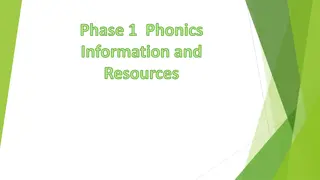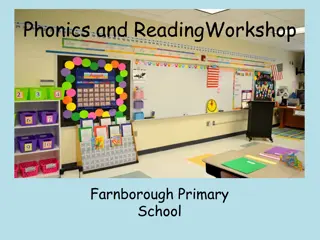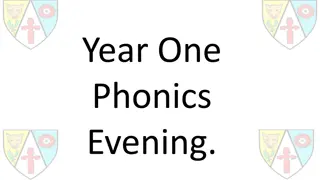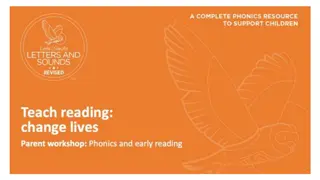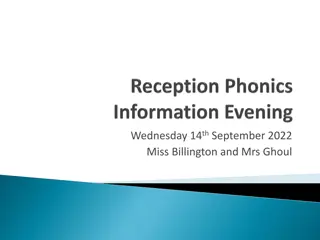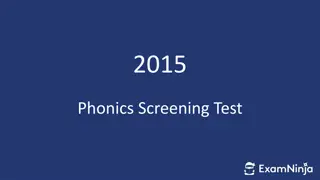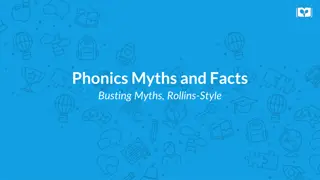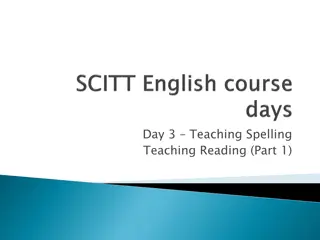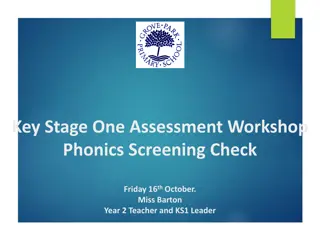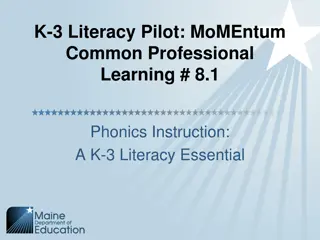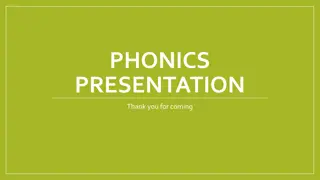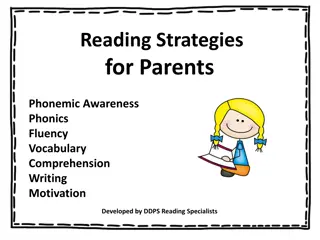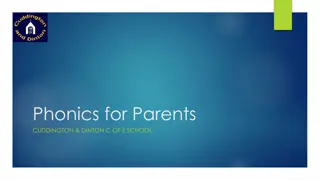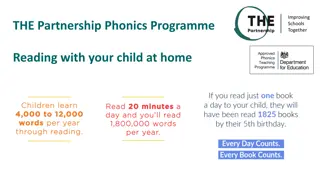Year 1 Home Learning English - Phonics and Reading Activities
Enhance your child's English skills at home with Year 1 home learning activities focusing on phonics, reading, and writing. Explore Phase 5 graphemes, tricky words, sight reading, and fun phonics games to improve literacy. Engage in reading activities with the class storybook "Handa's Surprise" by Eileen Brown. Access resources and tips to support your child's English learning journey.
Download Presentation

Please find below an Image/Link to download the presentation.
The content on the website is provided AS IS for your information and personal use only. It may not be sold, licensed, or shared on other websites without obtaining consent from the author. Download presentation by click this link. If you encounter any issues during the download, it is possible that the publisher has removed the file from their server.
E N D
Presentation Transcript
Year 1 Home Learning English
Key Skills and Knowledge: Phonics: - Learn the Phase 5 graphemes. We will be learning these over the half term. (ay, ou, ie, ea, oy, ir, ue, aw, wh, ph, ew, oe, au, eu, a-e, e-e, i-e, o-e, u-e) - Practise reading Phase 5 graphemes in words and sentences. - Learn the Phase 5 tricky words (see next slide) Reading: - Predict what might happen. - Discuss word meanings. - Make inferences. - Illustrate captions. Writing: - Say out loud what I am going to write about. - Sound out and spell words using my phonics knowledge. - Use adjectives to describe nouns. - Use tricky words in my writing. - Begin to use capital letters and full stops. - Use the conjunction and in a sentence. - Begin to use a question mark. As well as focusing on these skills, we will be continuing 1:1 reading with Big Cat phonics books. To access the Big Cat ebook library, click on the link and enter the name of the school and your child s details: https://connect.collins.co.uk/sch ool/defaultlogin.aspx
Phonics - Learn the Phase 5 graphemes, 1 per day for 4 days a week. To see which graphemes your child should be learning each week, check the table below. Flashcards can be found here: http://www.letters-and-sounds.com/phase-5-resources.html - Learn to sight read the Phase 5 tricky words (see table below). Week Graphemes taught Tricky words 1 ay, ou, ie, ea oh, their, people 2 oy, ir, ue, aw Mr, Mrs, looked, called, asked 3 wh, ph, ew, oe, au, ey said, so, have, like 4 a_e, e_e, i_e, o_e, u_e some, come, were, there - Recap Phase 3 and Phase 2 graphemes using flashcards: - http://www.letters-and-sounds.com/phase-2-resources.html - http://www.letters-and-sounds.com/phase-3-resources.html - Put aside any flashcard sounds that need more practise. Re-teach these one per day. Use Geraldine the Giraffe videos to support: https://www.youtube.com/playlist?list=PLFE759D814D8232E8 - Practise reading a few words containing Phase 2, Phase 3 and new Phase 5 sounds every day. Use word cards. - Phase 2 word cards can be found here: http://www.letters-and-sounds.com/phase-2-resources.html - Phase 3 word cards can be found here: http://www.letters-and-sounds.com/phase-3-resources.html - Phase 5 word cards can be found here: http://www.letters-and-sounds.com/phase-5-resources.html - Use the activities on the following slides to practise applying phonic knowledge. These activities can be spread over a number of days and adapted to the sounds your child is learning.
Phonics - Pick a sound and go on a sound hunt around the house. How many things can you find that have this sound in their word? - Pick a phase 3 or phase 5 caption. Read the caption and draw a picture to match it: - http://www.letters-and-sounds.com/phase-3-resources.html (scroll to the bottom) For Phase 5 captions, see file. - Choose a book you have at home. Look through and see if you can spot any words with the sound you have learnt today. - Play phonics games online using Phase 2, Phase 3 and Phase 5 sounds: http://www.letters-and-sounds.com/phase-2-games.html - http://www.letters-and-sounds.com/phase-3-games.html - http://www.ictgames.com/mobilePage/forestPhonics/index.html
Reading Our class story book this half term is Handa s Surprise by Eileen Brown.
Reading 1 Before listening to the story, look at the front cover and answer these questions: Who is Handa? What is this animal? What do you think the surprise is going to be? Can you name any of these fruits? Have you ever seen fruit being carried like this before? Which country do you think the story is set in? What is the weather like there?
Reading 2 Discuss the meaning of the word surprise . What is a surprise? Which of these faces shows a surprised expression? When do you feel surprised? When do we get surprises? Are surprises always good? Do you like surprises?
Reading 3 https://www.youtube.com/watch?v=QqdXBhyORug Listen to the story up to 2:37, then STOP. Answer the following questions: 2. What is Handa going to do with the fruit? 1. How many fruits does Handa put in the basket? 4. How will Handa feel when she notices the fruit is gone? 3. What happened to the fruit on the way? 5. How will Akeyo feel? What do you think will happen next?
Reading 4 Match the fruit to the animal that takes it in the story.
Reading 5 https://www.youtube.com/watch?v=QqdXBhyORug Listen to the whole story until the end. Discuss the questions below. What happened at the end of the story? Was it what you expected? How many surprises are there in the story? Who was surprised by what happened? What do you think would have happened if the goat hadn t bumped into the tree? Was Akeyo disappointed about the missing fruit? Why/ why not?
Match the words to the fruit. guava passion fruit mango banana orange avocado pineapple
Taste as many of the fruits in Handas Surprise as you can. Read the adjectives below and practise saying them to describe the fruits. Use the sentence stem: The ________ is _______ and ________. purple sharp waxy ripe round green yellow juicy sweet-smelling soft spiky-leaved creamy red bumpy tangy sweet sour
Choose a fruit to describe. Write adjectives around it using the words on the last slide. Remember to use your phonics knowledge to sound out and spell the words!
Write sentences to describe your chosen fruit, using adjectives. Challenge: can you use two adjectives, joined with and ? e.g.: The mango is red and shiny. It is sweet and orange inside.
What might the monkey be thinking? ____________________ ____________________ ____________________ ____________________ ____________________ Fill in the adjectives: I want that _________ _________ banana!
Your turn: write what the zebra is thinking about the orange. Remember to use adjectives. ____________________ ____________________ ____________________ ____________________ ____________________
Writing Questions Explain that this is a question mark, and that it is used instead of a full stop at the end of a question. Practise writing question marks in the air with your finger. In Handa s Surprise, there are lots of questions. Listen to the story again. Can you spot any? Using your adjectives from the last activity, practise writing questions about which fruit Akeyo will like. Use these sentence stems: Will she like the __________ __________ banana? Will she like the __________ __________ orange? And so on
Extra activities - Write sentences to re-tell the story of Handa s Surprise under the pictures in the storyboard (see Handa sSurprise Storyboard file). - Write a letter to Handa from Akeyo to say thank you for the tangerines. - Challenges: Can you use adjectives in your story or letter to describe the fruit? Can you use questions and question marks in your writing? Can you use and to join parts of your sentence?
